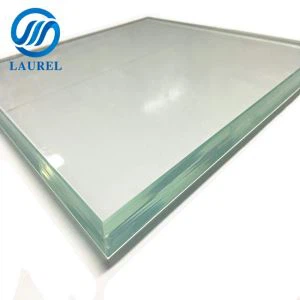Low-E laminated glass is produced with two or more thoroughly cleaned hard coated Low-E glass panels with one or more polyvinyl-butyralfoils (PVB) are mounted on each other in a clean room. Then the sandwich is pre-strengthened in a rolling process at approx. 200℃ heat and then put these glasses on a shelf into the autoclave with about 130℃ heat and 10 bar pressure.
With the sharp increasing of safety glass in all aspects of life, laminated glass has become a key component in the realization of modern interior decoration and exterior architecture due to its strength and safety features such as hurricane and impact resistance, protection against bombs or other explosions, sound reduction, glass floors and stairs, earthquake resistance, doors and windows.

Specifications
Thickness of glass |
4mm,5mm,6mm,8mm,10mm,12mm, |
Thickness of PVB |
0.3mm,0.38mm,0.76mm,1.14mm,1.52mm,1.9mm,2.28mm,3.04mm |
Colors of PVB |
Clear, Milky white, Bronze, Dark grey, Euro grey, Dark blue, Light blue, Dark green, Light Green |
Brand of PVB |
Decent, KB, DuPont, Solutia, Sekusui, Trosifol |
Type of glass |
Clear hard coated Low-E, Grey hard coated Low-E,SY48 hard coated Low-E, Clear float, Ultra clear, Bronze tinted float, Euro grey tinted float, Dark grey tinted float, Dark blue tinted float, Fort/Lake blue tinted float, F-Green tinted float, Dark green tinted float |
Size of hard coated Low-E laminated glass |
150*100mm-3300*2440mm |
Today, float glass is the most widely used form of glass in consumer products. Due to both its high quality with no additional polishing required and its structural flexibility during production, it can easily be shaped and bent into a variety of forms while in a heated, syrupy state. This makes it ideal for a variety of applications such as
Automobile glass (e.g. windshields, windows, mirrors)
Mirrors
Furniture (e.g. in tables and shelves)
Insulated glass
Windows and doors
Most forms of specialized glass such as toughened glass, frosted glass, laminated safety glass and soundproof glass consist of standard float glass that has been further processed.
Tempered or toughened glass is a type of safety glass processed by controlled thermal or chemical treatments to increase its strength compared with normal glass. Tempering puts the outer surfaces into compression and the interior into tension. Such stresses cause the glass, when broken, to crumble into small granular chunks instead of splintering into jagged shards as plate glass (a.k.a. annealed glass) does. The granular chunks are less likely to cause injury.
As a result of its safety and strength, tempered glass is used in a variety of demanding applications, including passenger vehiclewindows, shower doors, architectural glass doors and tables, refrigerator trays, mobile screen protectors, as a component of bulletproof glass, for diving masks, and various types of plates and cookware.
Tempered glass is physically and thermally stronger than normal glass. The greater contraction of the inner layer during manufacturing induces compressive stresses in the surface of the glass balanced by tensile stresses in the body of the glass. For glass to be considered tempered, this compressive stress on the surface of the glass should be a minimum of 69 megapascals (10,000 psi). For it to be considered safety glass, the surface compressive stress should exceed 100 megapascals (15,000 psi). As a result of the increased surface stress, if the glass is ever broken it only breaks into small circular pieces as opposed to sharp jagged shards. This characteristic makes tempered glass safe for high-pressure and explosion proof applications.
It is this compressive stress that gives the tempered glass increased strength. This is because annealed glass, which has almost no internal stress, usually forms microscopic surface cracks, and any applied tension gets magnified at the surface, reducing the applied tension needed to propagate the crack. Once it starts propagating, tension gets magnified even more easily, causing it to propagate at the speed of sound in the material. Consequently, annealed glass is fragile and breaks into irregular and sharp pieces. Any cutting or grinding must be done prior to tempering. Cutting, grinding, and sharp impacts after tempering will cause the glass to fracture.
The strain pattern resulting from tempering can be observed by viewing through an optical polarizer, such as a pair of polarizing sunglasses.
Tempered glass is used when strength, thermal resistance, and safety are important considerations. Passenger vehicles, for example, have all three requirements. Since they are stored outdoors, they are subject to constant heating and cooling as well as dramatic temperature changes throughout the year. Moreover, they must withstand small impacts from road debris such as stones as well as automobile accidents. Because large, sharp glass shards would present additional and unacceptable danger to passengers, tempered glass is used so that if broken, the pieces are blunt and mostly harmless. The windscreen or windshield is instead made of laminated glass, which will not shatter into pieces when broken while side windows and the rear windshield are typically tempered glass.
Other typical applications of tempered glass include:
Balcony doors
Athletic facilities
Swimming pools
Facades
Shower doors and bathroom areas
Exhibition areas and displays
Computer towers or cases
http://www.laurelglasstech.com/




 By certification
By certification 





